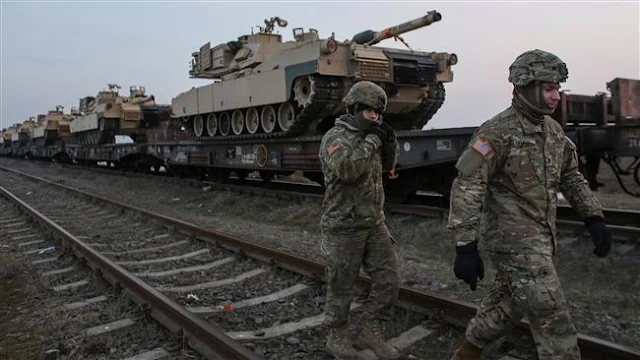NATO troops and Armored vehicles of the 3-29 Alpha Battery, arrive at Mihail Kogalniceanu Air Base, Romania. Russia warned U.S. of violati...

Russia warned U.S. of violating a peace treaty between Moscow and the Western military pact NATO after the Pentagon deployed another new force in the tense Baltic region. It's the latest of several Western moves seen as provocations by the Kremlin, which has vowed to respond. Vladimir Shamanov, head of the Defense Committee for Russia's lower house of parliament, said the country would consider adding more nuclear-capable Iskander ballistic missiles on its side of the border to deter a U.S. military buildup in the region.
The U.S. announced Thursday the arrival of the 2nd Cavalry Regiment in a Polish NATO outpost located about 100 miles from Russia's militarized enclave of Kaliningrad. The troops are part of Washington's latest effort to bolster allied nation's against what they perceive to be a military threat from neighboring Russia. Moscow, however, has constantly calling the U.S. and its NATO allies of undermining Russia's own security by surrounding it with hostile forces.

Soldiers of the U.S. Army 3rd squadron, 2nd Cavalry Regiment inbound in Romanian territory

The announcement of fresh deployments, which will include air, sea and land forces, came after NATO Secretary General Jens Stoltenberg met with Romanian President Klaus Iohannis in Bucharest, Romania’s capital city. During the meeting last Monday in Bucharest, NATO announced the formation of a 10-nation force in Romania, near the strategic Black Sea, where both NATO' and Russian military presence have contended for influence.
Romanian President Klaus Iohannis used a pretext to emphasizing that the purpose of additional deployment was for the "peace, not war," but Russia condemned the move as well as terming it an "unacceptable provocative" resolution adopted by the U.S.-led alliance censuring Russia for its actions in the Black Sea, according to state-run RIA Novosti.
The contingency of extra force include troops from Italy, Canada,and other NATO member nations, who will join roughly 900 U.S. troops. Along with 3,000 to 4,000 troops drawn from other NATO members like Portugal and Germany, Great Britain is also expected to send fighter jets to stay in Romania.
In January this year, America sent about 4,000 U.S. troops headed to Germany and then began rotations around Eastern Europe. NATO has significantly expanded its military presence near Russia, especially among the three Baltic states Estonia, Latvia and Lithuania and Poland. These four nations were designated by the U.S. last year to host NATO battle groups permanently, but the multinational coalition once again has expanded its forces beyond the normal peaceful accord of UN, this drawing further Russian fury.
U.S.-Russia relations declined drastically under the administration of former President Barack Obama and, after a brief respite following the election of President Donald Trump, have once again plunged. The White House and Kremlin have pledged to coordinate in defeating the Islamic State militant group (ISIS) in Syria, but both sides still have major grievances toward the other's global interests.
The Science and Tech weblog, is about science,technology,esoteric and international breaking news with national interest.







